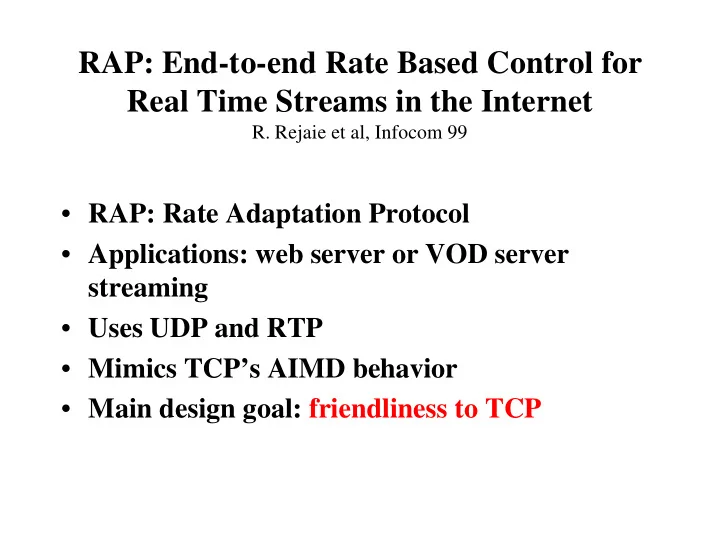

RAP: End-to-end Rate Based Control for Real Time Streams in the Internet R. Rejaie et al, Infocom 99 • RAP: Rate Adaptation Protocol • Applications: web server or VOD server streaming • Uses UDP and RTP • Mimics TCP’s AIMD behavior • Main design goal: friendliness to TCP
• End to end, application level implementation • Layer encoded, stored real time stream • Source adapts rate by adding/removing layers based on ETE feedback
RAP Mechanism • Receiver individually ACKs packets • It delivers packets to playout buffer even if received out of order • Each ACK carries sequence # • Sender estimates round trip time SRTT from ACKs • Sender keeps packet timers and checks for potential timeouts
RAP (cont) Increase/decrease (AIMD) alg: • Rate adjusted each SRTT • No loss: add one more packet in SRTT • Loss detected: reduce # of packets per SRTT by ½ (like in Reno) • “Cluster loss” (ie, many consecutive packets lost): react only to first loss – similar to TCP SACK behavior
RAP (cont) • RED (Random Early Drop) used to limit the burst loss occurrence • RED improves TCP-friendliness: it allows TCP to catch up with RAP
Simulation experiments NS-2 TCP flows: FTP Resources are scaled up proportionally to # of users.
FG = fine grain adaptation; It adjusts rate continuously
TCP friendliness • RAP not very friendly to Tahoe! • Tahoe suffers from frequent time outs and slow-start episodes • Other TCP versions fare better • In following experiments, TCP SACK is used
TCP-SACK in use
TCP friendliness • Half flows are RAP, half are TCP • Fairness ratio = avg RAP thrpt/avg TCP thrpt • RAP fair to TCP SACK (except for small # of flows and small round trip delays)
RED Gateways
Fairness = RAP thr/TCP thr Max p = 0.16; short queue hurts TCP .005; large queue
RAP behavior with RED If max p is too small (eg .005): Avg queue size grows large, packets are tail- dropped; system has large queue fluctuations – With small # of flows, the period is large; TCP recovers less easily than RAP – With large # of flows, the period is shorter; TCP flows are hit less than the evenly spaced RAP flows; RAP performs poorly!
RAP behavior with RED (cont) • As max p is increased, more packets are random dropped and the queue becomes more stable • Buffer utilization (and throughput) are lower • TCP congestion window becomes small, and RAP takes advantage of it, “stealing’ the avail bandwidth from TCP flows
Conclusions • RAP is reasonably TCP friendly in large scale nets (many flows) and large windows • With a few flows, the scheme becomes unfair • RED improves fairness; but parameters must be properly tuned; bed RED param selection (eg, max p = .005) can harm real time traffic!
Recommend
More recommend